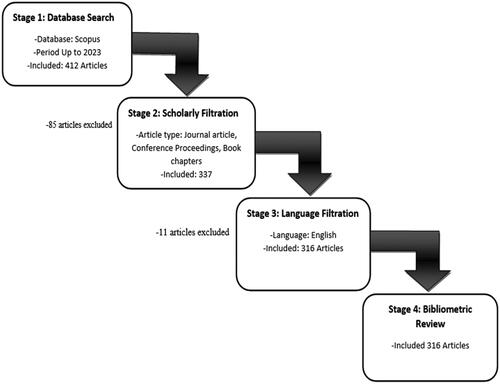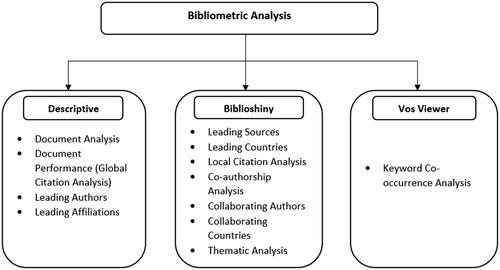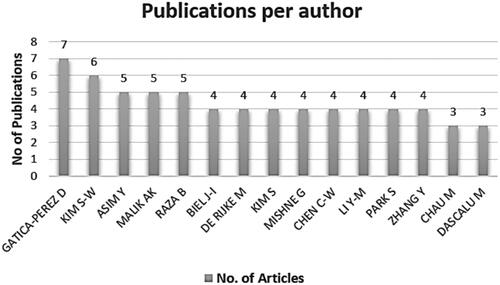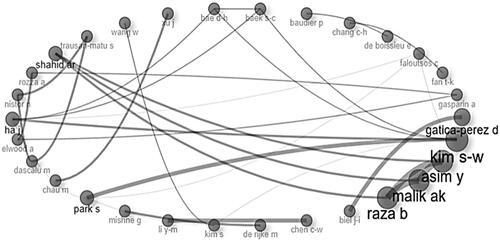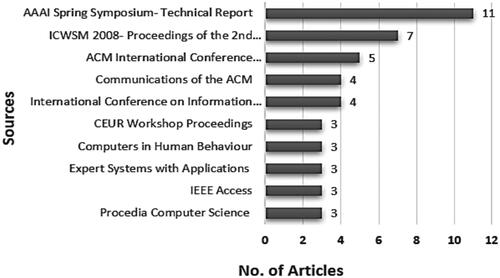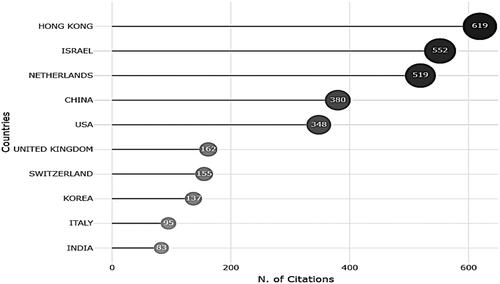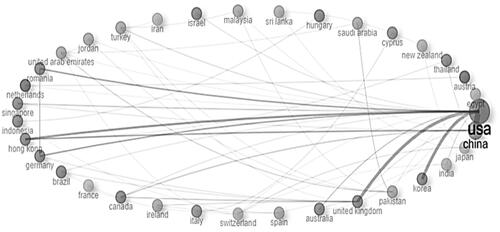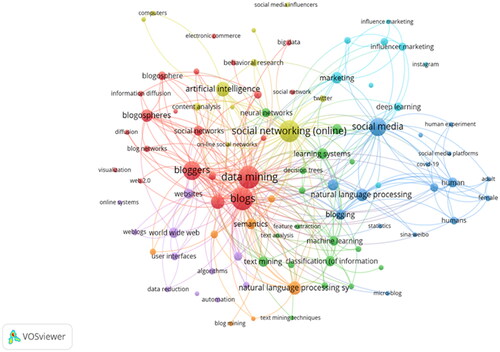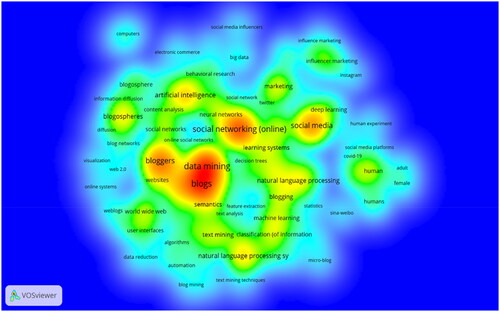Abstract
Artificial intelligence represents the cutting-edge frontier in influencer marketing, offering a novel approach to leveraging social media data. This study aims to provide a comprehensive analysis of the recent state and future directions of artificial intelligence-infused influencer marketing through bibliometric analysis. For substantial bibliometric analysis, the study contains 316 documents published in journals indexed in the Scopus database for the period ranging from 2004 to 2023. The yearly publications have risen from 2 in 2004 to 55 in 2023, with an average age of 19.06 years and a citation rate of 22.19 yearly. The number of publications in this domain accelerated in 2020. According to the review findings, Hong Kong is the most productive country in this research domain. The leading affiliation is Hanyang University. The top contributing author is Gatica Perez-D. The most prolific source is the AAAI Spring Symposium Technical Report. Keyword occurrence analysis highlights prevalent terms such as Blogs, Social media networking (online) and Data mining alongside emerging keywords such as Influencer marketing, User-Generated Content, Artificial Intelligence, Sentiment Analysis, and Semantic Analysis in this domain to anticipate future inclinations. Performance analysis, further delves into Collaborative efforts among countries, sources, affiliations and authors have also been done using tools like Biblioshiny and Vos Viewer. The study offers novel contributions to the existing literature in terms of comprehensively providing evidence of the current practices of AI-integrated influencer marketing.
1. Introduction
Initially, Blogs were the main source for people to get information about anything (Bronstein, Citation2013). But since 2017 social media started gaining importance because a large number of people started using different social media platforms daily. Individuals who have an account on a social media platform with a large number of following and regularly post content on it are known as an influencer. People follow them because of their diversified content. Because of the large audience of influence brands find it a good strategy and start collaborating with these influencers to engage with a large audience and promote their product and services. Influencers have gained a solid reputation in the market. Thus, it becomes very difficult for marketers to find the right influencers (Vrontis et al., Citation2021).
Wherein, Artificial intelligence (AI) refers to the simulation of human brains in devices that have been designed to act and think like people. AI has gained popularity since 2015 with different tools like robots, chatbots etc. AI improves efficiency reduces time and improves governance through better decision-making. AI is the newest and most innovative way to use influencer marketing (IM). Data from social media can be extracted by using artificial intelligence-integrated influencer marketing. AI-integrated influencer marketing is at the epicentres of research scholars and practitioners while receiving immense devotion in the recent literature. Influencer marketing (IM) is an important and prospering section of the digital marketing industry.
Organisations are using AI to assess the influencer’s performance and to find the right influencer with whom they can collaborate (Mileva, Citation2023). Because of the extremely growing sector, researchers and practitioners are keenly showing their interest in these domains. And that is why publications on AI and IM are increasing day by day as shown in . Therefore, this growth raises the need to do a bibliometric review.
Previous scholars such as (Kumar & Singh, Citation2019) presented the quality of information that existed online about probiotic products by detecting virtual communities and identifying key influencers in social media. (Stella, Citation2022) presented a brief review on cognitive network science through online media that bridges emotional content and social dynamics by comparing multilayer networks with the mindsets of influencers and followers. (Yang et al., Citation2021) did a comparative study on audience reaction to content posted by influencers with brand sponsorship and computed influencers’ large volume of social media texts. (Argyris et al., Citation2020) did an empirical investigation on IM on Instagram using deep-learning algorithms for automatic image classification.
Moreover, To the best of our understanding, no review on AI and IM was published within the last 10 years that has adopted bibliometric analysis for review. This contention is also validated through Scopus search that no bibliometric review has been published on AI and IM.
Thus, the following research questions have been explored in this review:
RQ1. What is the publication productivity of research on AI and IM?
RQ2. What are the most influential authors on AI and IM?
RQ3. What are the top contributing (sources, countries and affiliations) of AI and IM?
RQ4. What are the most prominent research topics and themes on AI and IM?
2. Background of artificial intelligence and influencer marketing
2.1. Artificial intelligence
Artificial intelligence is designed to mimic the human brain and make decisions similar to those made by humans in a variety of settings (Bar-Ilan, Citation2004). Artificial intelligence is a technique that gives businesses the chance to obtain a competitive edge by utilising large data to specifically address the needs of their clients through individualised offerings (Li & Chen, Citation2009). It is a gadget that behaves, thinks, and learns exactly like a human. The world became a web of interconnected networks as technology advanced. The realm of artificial Intelligence has diverse applications across a wide array of businesses such as Investment. In parallel with how organisations are transitioning to Industry 4.0, cutting-edge technology such as artificial intelligence is developing. Even though many obstacles are preventing the widespread adoption of artificial intelligence (AI), scientists are working on systems that support the theory of mind and self-awareness of AI systems so that big data analytics can generate market intelligence as a result of the technology implementation.
Artificial Intelligence (AI) technology is a groundbreaking force in today’s landscape, fundamentally altering our interactions with and understanding of the digital realm. Essentially, AI involves the creation of computer systems capable of performing tasks traditionally requiring human intelligence, including learning, reasoning, problem-solving, and language comprehension. One key application of AI is machine learning, a subset that enables systems to learn from data and enhance their performance without explicit programming. This adaptability and evolution based on experience have led to significant advancements across various domains, spanning healthcare, finance, education, and entertainment (Sharma & Bahl, Citation2023). In the business sphere, AI technologies offer unprecedented opportunities for efficiency and innovation. Through automation driven by AI, mundane tasks are streamlined, freeing up human resources to focus on more intricate and creative aspects of their roles. Moreover, AI algorithms enhance decision-making processes by analysing extensive datasets, providing valuable insights, and refining the precision of strategic decisions.
With the proliferation of AI-driven tools and algorithms, marketers are harnessing the power of machine learning and natural language processing to optimize influencer selection, content creation, and audience targeting (Mileva, Citation2023). AI-powered platforms offer invaluable insights into consumer behaviour and preferences, enabling brands to identify the most relevant influencers for their campaigns and tailor content that resonates authentically with target audiences. Moreover, AI-driven analytics facilitate real-time performance monitoring and optimization, allowing marketers to adapt strategies dynamically and maximize campaign impact (Ballestar et al., Citation2022).
2.2. Influencer marketing
Influencer marketing has undergone a fascinating evolution, beginning with the rise of blogs as a platform for individuals to share their opinions and expertise. Initially, businesses recognized the potential of partnering with influential bloggers to reach niche audiences with authentic content. This phase marked the early stages of influencer marketing, characterized by organic partnerships and genuine endorsements (Vrontis et al., Citation2021). As social media platforms emerged, celebrity endorsements became a dominant force in influencer marketing. Brands leveraged the massive followings of celebrities to amplify their message and reach broader audiences. This era saw the birth of sponsored posts and collaborations with well-known personalities across various industries.
These well-known personalities are known as influencers. They are the users on social media platforms who have a large number of followers because of their credible content (Ao et al., Citation2023). Because of the large audience, brands are using influencers to collaborate with them to promote and review products. Despite this, users feel annoyed and confused because of the sponsored post character and it leads to frustration and anger among users because of unclarity on the influencer’s credibility (Aw & Agnihotri, Citation2023). Because of their vast reach and business knowledge, social media influencers are receiving a lot of attention from marketers. Influencer marketing has undergone a fascinating evolution, beginning with the rise of blogs as a platform for individuals to share their opinions and expertise. Initially, businesses recognized the potential of partnering with influential bloggers to reach niche audiences with authentic content. This phase marked the early stages of influencer marketing, characterized by organic partnerships and genuine endorsements (Vrontis et al., Citation2021). As social media platforms emerged, celebrity endorsements became a dominant force in influencer marketing. Brands leveraged the massive followings of celebrities to amplify their message and reach broader audiences. This era saw the birth of sponsored posts and collaborations with well-known personalities across various industries.
The subsequent shift towards nano influencers marked a turning point in influencer marketing, emphasizing quality over quantity. Nano influencers, with relatively small but highly engaged followings, offered brands the opportunity to connect with niche audiences on a more personal level. Their authenticity and relatability resonated with consumers, leading to increased trust and brand loyalty. Micro-influencers further refined this approach by focusing on specific niches and communities (Vidani & Das, Citation2021). With follower counts ranging from a few thousand to around 100,000, micro-influencers cultivated deeply engaged audiences based on shared interests or demographics. Brands recognized the value of these genuine connections and began prioritizing partnerships with micro-influencers to drive authentic engagement and conversions (Kanaveedu & Kalapurackal, Citation2022). The rise of macro influencers introduced a new dynamic to influencer marketing, with individuals boasting follower counts in the hundreds of thousands or even millions. While macro-influencers offered broader reach, they sometimes struggled to maintain the authenticity and credibility associated with smaller influencers. Nevertheless, brands continued to leverage their influence to increase brand awareness and visibility on a larger scale. More recently, the concept of mega influencers has emerged, representing individuals with enormous followings and significant influence across multiple platforms (Böhndel et al., Citation2023). These influencers, often celebrities or public figures, command immense reach and influence, making them sought-after partners for brands aiming to make a big impact. Companies think communicating with influencers is a useful strategy to maximise their investment in social media. Social media influencers have a significant impact on how businesses market themselves as a result of the proliferation of social media platforms. Brands are depending more and more on social media influencers as a marketing strategy. The organisation works with social media influencers who are motivational and good organisation works with social media influencers who are motivational and good.
In parallel, the industry has witnessed the emergence of a new trend distinct from traditional influencer marketing: the rise of virtual influencers (VI), these computer-generated personalities and artificial intelligence blur the line between reality and fiction, offering brands a unique opportunity to engage with audiences in immersive and innovative ways. Virtual influencers are defined as ‘entities, whether human-like or not, autonomously controlled by artificial intelligence and visually represented as interactive, real-time rendered beings in a digital setting (Gupta, Citation2022). While virtual influencers are still relatively new, their potential to captivate audiences and drive brand engagement is undeniable, signalling a fascinating new chapter in the evolution of influencer marketing.
The subsequent sections elaborate on the particular procedures and methodologies employed in the review.
3. Methodology
3.1. Bibliometric search
The ‘Bibliometric’ is one of those methods that is mostly used to evaluate the literature. 2.3 Combining several bibliometric approaches promotes a deeper comprehension of problems in that area of research. Bibliometric assessments of AI and IM have been performed in several kinds of research. (Bar-Ilan, Citation2004) stated that the extreme growth of blogs and the different attributes that are used in blog posting. The following are the attributes that the author mentioned in the document the theme of the blog posting, length of the blog, links to add to blog posting, relation between links and bogs posting and placement of those links in blog postings. (Li & Chen, Citation2009) Stated that blogs have become viral marketing sites because they contain a large number of information and this becomes problematic for the blog reader to retrieve the important information. The author proposed a blog recommendation mechanism which combines information that is trustworthy, reliable, socially intimate, popular and semantically similar. (Li et al., Citation2010) To evaluate the influence and determine the influential bloggers in the blogosphere, a marketing influential value model with three aspects was developed: the aspects are content-based, network-based and activeness-based. Marketers can effectively apply this model to promote their products and services. (Quan & Ren, Citation2016) designed a blog emotion visualisation system and to implement this system machine learning methods are applied to detect emotions in blogs. This helps to evaluate the performance of sentence emotion. (Yang et al., Citation2020) demonstrated that brands are utilising influencers for the promotion of their product and influencers are mentioning the brand on their social network. Audiences are showing highly similar reactions to sponsored and non-sponsored posts and to classify the sponsorship post the author has proposed a neural network-based model by utilizing the network embedding and social media features (Mileva, Citation2023). To further elucidate the literature on AI and IM, a bibliometric review has been conducted on AI and AI research. In the next sections, specific procedures and methods of the review are explained.
In this review paper bibliometric study has been conducted to represent the overall research work on AI and IM in the SCOPUS database (Broadus, Citation1987). The data of the period from 2004 to 2023 have been covered, where the centre of attention is on the data of completed recent studies. To do the bibliometric search review, mainly four stages have been developed that consists: Database search, Scholarly filtration, Language filtration and Bibliometric review in (Donthu et al., Citation2021).
Database search is the first stage. Scopus has been chosen first, due to the extensiveness of the bibliometric data for documents that it indexes and secondly, (Aria & Cuccurullo, Citation2017) due to its scope of productions that met a tough set of requisites for indexing. Scopus is a scientific database that is frequently suggested for bibliometric evaluations, and it is excellent for projects looking to curate a sizable corpus for review (Heradio et al., Citation2016). Importantly, Scopus has been acknowledged as a high-quality source for bibliometric data, and the correlation between its measures and those found in other scientific databases like the Web of Science is ‘extremely high’, despite the latter’s coverage being less than the former (Marshakova-Shaikevich, Citation2005; Singh & Dhir, Citation2019). As a result, Scopus is a higher-quality but more comprehensive source of data for review.
we chose ("social media influencer marketing" OR "social media influencer*" OR "YouTube influencer*" OR “nano influencer*” OR “virtual influencer*” OR "Facebook influencer*" OR "online influencer*" OR "micro-influencer*" OR "macro influencer*" OR "mega influencer*" OR "human influencer*" OR "Instagram influencer*" OR "video blogger*" OR "Snapchat Influencer*" OR "vlogger*" OR "blogger*" OR "YouTuber*" OR "digital influencer*" OR "influencer marketing") AND ("artificial intelligence" OR "neural networks" OR "deep learning" OR "data learning" OR "voice recognition" OR "text mining" OR "Data mining" OR “social network analysis” OR “robot*” OR “chatbot*” OR “natural language processing” OR “speech recognition”)
As our search keyword due to its prominence as a concept in our analysis, we decided to focus only on search up to 2023 for rational reasons. the result came using a database search was 412 documents (Snyder, Citation2019). Scholarly filtration was the second stage. In this stage, we include only conference proceedings, journal publications, and book chapters due to the grounds of novelty on which they were evaluated and also due to precise peer review (Kessler, Citation1963). Researchers did not include a conference review. this stage excluded 85 documents and this included 337 documents only (Kent Baker et al., Citation2020). Language filtration is the third stage. We included documents written in English language only as we all are vernacular speakers and reviewing with a large data set is impractical when translation works (Zupic & Čater, Citation2015). This stage excluded 11 documents. Altogether, 316 publications are retained for bibliometric analysis within these stages as indicated in .
To address our first research question (RQ1), where we conducted document analysis and citations analysis to identify the most influential articles globally and locally. Citation analysis helps gauge a document’s popularity and helps researchers in locating impactful publications. To address our second research question (RQ2), we conducted a Co-authorship analysis to examine collaboration trends among countries and authors, which is crucial for assessing collaborative efforts. For our third research question (RQ3), we sought to identify the top contributors in terms of sources, authors, countries and affiliations. can be ascertained and is an impactful tool to assess trends and address our fourth research question (RQ4), we employed Keyword co-occurrence analysis and major themes through thematic analysis to map the intellectual structure of AI and IM. By identifying key themes and influential keywords, we can understand the underlying concepts and trends in these fields. To find the answer to all these research questions and visualize the network ‘Biblioshiny’ and ‘Vos viewer’ have been used using the techniques mentioned in (Boyack & Klavans, Citation2010). This study serves as a valuable resource for academics, shedding light on novel areas within AI and IM. It also facilitates the identification of productive authors and organizations, aiding researchers in finding potential collaborators and academic institutions. Moreover, it provides insights into impactful research documents, which can serve as foundational pillars in these fields. This information is invaluable for future researchers seeking to advance knowledge in AI and IM.
Table 1. Strengths and weaknesses of the techniques applied.
4. Results and interpretations
4.1. Descriptive analysis (RQ1)
The summary statistics in represent the record of published data comprising 250 sources, 888 authors and 316 documents. This progress is with an average annual publication of 19.06% and an average annual citation of 22.19. The collaboration index of 3.21 and 888 authors used 11312 references and 1766 keywords, which indicates a good collaboration of researchers in this domain.
Table 2. Summary statistics of documents under review corpus.
4.2. Document analysis
Publications in this domain started increasing in 2021 and have followed a steady rise with an annual growth rate of 19.06% within the period of 2004–2023, 316 documents were published. During this tenure, the documents progressed from 2 in 2004 to 55 in 2023. In the marketing sector, influencer marketing has seen a significant rise in popularity due to its benefits associated with brands utilizing artificial intelligence depicts the annual publications and it is evident that the highest number of research documents were published in the year 2023 with 55 documents.
4.3. Documents performance
4.3.1. Global citations
Global citations are the total number of citations to an article in the Scopus database that was acquired without any filtering (such as subject filtration). represents, the document with the most global citations ‘The political blogosphere and the 2004 U.S. election’ (1903 citations) which is authored by Adamic and Glance (Citation2005). It is followed by an article titled ‘Effects of Age and Gender on Blogging’ authored by Schler et al. (Citation2006) (505 citations) and ‘Rise and Fall Patterns of Information Diffusion: Model and Implications’ with (274 citations) (Matsubara et al., Citation2012)
Table 3. Top cited documents of AI and IM based on global citations.
4.3.2. Local citations
Local citations are, to put it simply, citations found in works included in the review corpus. represents the most locally cited document ‘Effects of Age and Gender on Blogging’ authored by Schler et al. (Citation2006) (with 9 citations), which is followed by ‘Conversations in the Blogosphere: An Analysis from the Bottom Up’ authored by Herring et al. (Citation2005) (with 8 citations) and ‘The political blogosphere and the 2004 U.S election’ authored by Adamic and Glance (Citation2005) (with 8 citations).
Table 4. Top cited documents of AI and IM based on local citations.
4.4. Top contributing authors (RQ2)
888 authors contributed 316 productions to research regarding AI and IM. depicts the highly active authors with several documents. The top two leading authors with the most publications are (Biel & Gatica-Perez, Citation2011, Citation2021; Gatica-Perez et al., Citation2018) (7 articles), followed by (Gatica-Perez et al., Citation2018; Kim et al., Citation2021) (6 articles). Bloggers create content, build connections with other bloggers so they may share content, and combine these activities to create a blog network, an online social network. According to social network theory, information dissemination happens as a result of connections among the individuals who make up a social network. When the history of information diffusion in the actual blogosphere is analysed, however, it is found that most of the information moves between the constituents without any established association, in contrast to the social network theory. Also noted is the phenomenon of explosive information spread. This research illustrates the relationship between these two phenomena using data from actual blogs and investigates the factors that lead to explosive information diffusion.
4.4.1. Most influential authors
The authors play a significant role in the evolution of a research stream. shows the top 15 authors based on their number of publications, Citations received and h-index that helps to obtain the picture that takes into account the most influential author.
Table 5. Top influential authors.
represented that Gatica-Perez D is the author with the highest number of publications and h-index (7 publications with h-index 5) in this research domain followed by Kim S-W with the second highest number of publications with (6 publications with h-index 3). Chau M is the author with the highest number of citations (489 citations) followed by Mishne G second highest with (415 citations). The threshold was a minimum of 3 papers by author. (Gatica-Perez et al., Citation2018; S. Kim et al., Citation2021).
4.4.2. Network of Co-authorship analysis
When authors work together and collaborate on an article is known as co-authorship analysis. The depicts the co-occurrence between the author on AI and IM through network analysis. The circular nodes represent the contribution of each author in terms of the number of papers published by them. The bigger the size of the node denotes higher the number of publications by that author. The lines joining the nodes represent the frequency of collaboration between two authors. Thicker the joining line indicates more frequent collaboration between them. The network diagram depicts the top 40 authors engaged in collaboration with their counterparts. It is interpreted from the analysis that the most collaborating author is Gatica-Perez D as he collaborated with 6 other authors, followed by Kim S-W, Asim Y, Malik AK, Raza B and Shahid AR has collaborated with 3 authors each (Kim & Baek, Citation2022; Nkoulou Mvondo et al., Citation2022). It is also observed that due to the thickest node, the pair of Gatica Perez D (Biel & Gatica-Perez, Citation2011, Citation2021; Gatica-Perez et al., Citation2018) and Park S (Kwon et al., Citation2009) is the most collaborating pair in this domain.
4.5. Top contributing sources (RQ3)
The existing publications on this domain have been examined in this review and all are sourced from a total of 250 different sources.
Amongst 316 documents, a list of the top 10 sources has been taken who have published articles based on IM and AI during the tenure of 2004 to 2023 shown in . The top three considered sources are AAAI Spring Symposium- Technical Report (11 articles), ICWSM 2008- Proceedings of the 2nd International Conference on Weblogs and Social Media (7 articles), ACM International Conference Proceeding Series (5 articles) and the list continues.
4.5.1. Top contributing sources
To ensure a comprehensive examination of the most impactful research, a well-rounded understanding of the topic has been obtained from top contributing sources.
shows the most productive sources with a higher cumulative frequency of citations Among these 12 sources shown in the , the AAAI Spring Symposium Technical Report is the most contributing source with 11 publications, 1092 citations and h-index 8. It is followed by ICWSM 2008- Proceedings of the 2nd International Conference on Weblogs and Social Media (S. Kim et al., Citation2021) with 7 publications. It is followed by the Proceedings of the 3rd International AAAI Conference on Weblogs and Social Media, ICWSM with 127 citations. International Conference on Information and Knowledge Management, Proceedings with h-index 4. This representation of sources helps in determining the performance of the sources and their importance.
Table 6. Top contributing sources.
4.6. Top cited countries
Worldwide, 34 countries have contributed so far in AI and IM. represents the 12 countries with at least 70 citations. Research documents by Hong Kong have the greatest number of citations with 619 citations. Israel and the Netherlands follow it with 552 and 519 citations respectively. The list of top five leading countries includes Hong Kong, Israel, Netherlands China and the USA with 2418 citations in aggregate.
4.7. Top collaborating countries
Biblioshiny was used for the network visualisation of countries’ collaboration contributing to the research of AI and IM. depicts that the first major cluster/collaboration involves the USA, which is the heart of international collaborations with the UK, Korea, China, Germany, Canada, Brazil, Thailand, Australia, Hong Kong, Romania and Singapore. The second major cluster/collaboration among Saudi Arabia, Malaysia, Turkey, Jordan, United Arab Emirates and Pakistan. The third major cluster/collaboration is among India, Japan and Switzerland. The other collaboration is between the Netherlands and Austria, Spain and Ireland, Indonesia and Hungary, Cyprus and South Africa, and Sri Lanka and New Zealand.
4.8. Top contributing affiliations
represents the dissemination of publications by affiliations. The table depicts that Hanyang University in South Korea is the leading affiliation contributing to the research of AI and IM (13 documents) followed by Comsats University Islamabad in Pakistan (12 documents), followed by the University of Amsterdam in the Netherlands (11 documents).
Table 7. Top affiliations.
4.9. Keywords analysis (RQ4)
Through network visualisation of co-authorship analysis in it is noted that there are 7 clusters in the network that future researchers can opt for in the research domain of Influencer marketing and Artificial intelligence. The related clusters of AI and SMI are bloggers, data mining, blogs, social networking (online), marketing, social media, natural language processing, blogospheres, and semantics. depicts the studies that mostly used these keywords: bloggers, data mining, blogs, social networking (online), marketing, social media, natural language processing, blogospheres and semantics the future researcher is advised to go through deeper into these studies.
Table 8. Occurrence of keywords in the network.
In density of the keywords depicts the deeper area in dark yellow colour saying that blogs, bloggers, data mining, social media, social networking (online), blogospheres, natural language processing and blogging are some keywords on which researchers have worked very much. On the other side, the portion in the light yellow and green area says that researchers are gradually starting to explore this research domain with these keywords as well. The keywords are influencer marketing, User-generated content, Artificial intelligence, Sentiment analysis, Semantic analysis etc. Future researchers can delve deeper into these keywords.
4.10. Major themes
The basic themes that are popular in the research domain of AI and IM are extracted by thematic analysis and are discussed as follows:
Cluster 1- Customer Engagement through Infusing AI into MI: The articles of this cluster discussed customer engagement. (Kwon et al., Citation2009) A new way to endorse a product through social media interaction is by the use of influencers. This increases the engagement between followers and the users i.e. influencers through the post. (Argyris et al., Citation2020) to build strong connections with followers influencers use visual congruence as a representation of shared interest in a particular area. (Feng et al., Citation2021) influencers post on social media in the form of narratives to make the advertisement disclosure by using learning-based topics or deep learning-based images to engage customers. (Rutter et al., Citation2021) says that influencers have higher network engagement efficiencies than celebrities because of their expertise and subject efficiency. (Silva & Costa, Citation2021) Avtar-based influencer marketing generates engagement with followers through the credibility, narrative of their personal stories and authenticity.
Cluster 2- Influencer Classification The articles in this cluster discussed about influencers. (Rodríguez-Vidal et al., Citation2020) influencers’ posts do not only depend on their expertise but also on that of their followers. (Baudier et al., Citation2023) says robot influencers are encroaching increasingly on the internet by interacting with humans and promoting brand content and values. (Alboqami, Citation2023) highlighted that consumer trust can be driven by AI influencers through five sources these are Source attractiveness, congruences, source credibility and attractiveness. (Simay et al., Citation2022) says that the adoption of AI applications by SMI leads to an effect on the e-wom intention of customers. (Sands et al., Citation2022) virtual influencers are gaining popularity but at the same time giving rise to falsifying and artificially created and manipulated influencers. (Rodríguez-Vidal et al., Citation2020) states that virtual influencers are trending in marketing because they can emulate human appearance and behaviour. But brands shield themselves from scandals of human influencers through investigation.
Cluster 3- Content Analysis: The articles in this cluster discussed about content analysis of blogs. (Chau & Xu, Citation2007) highlighted that blogs are user-generated content that provide useful information which is helpful for business intelligence, good opportunities and offers products to the consumer. (Y.-M. Li & Chen, Citation2009) emphasized that Micro-blogs are something which is very short and every individual has a distinct way of expressing emotions which creates problems in micro-blogs. (Chau & Xu, Citation2012) illustrated that blogs have become personal diaries where everyone can freely express their emotions and opinions which the virtual communities can read and share their ideology. (Truelove et al., Citation2015) indicated that events about to happen in future can be harvested from blogs because the information derived is credible. (Ulicny et al., Citation2007) stated that the new arena of blogs represents an intelligent gathering of information. The information should be relevant, credible, specific and timeliness. (Sandeep & Patil, Citation2018) identifies that bloggers share their personal experiences or opinions on a certain topic in a blog.
Cluster 4- Morphology of Bloggers Post: (Rzepka & Araki, Citation2015) explored that human experiences and thoughts about bloggers can be evaluated using text mining techniques to enrich knowledge. (Teng & Chen, Citation2006) highlighted that bloggers are doing good day by day and to detect their interests three features have been mentioned by the author ‘Textual’ to know the interest of the bloggers related to the words they used. ‘Temporal’ to evaluate the frequency of bloggers to understand the strength of their interest. ‘Interactive’ shows the comments that bloggers make in the blogosphere to identify others. (Bronstein, Citation2013) stated that bloggers are creating good content through virtual presence by self-presenting and disclosing their personal experiences blogger’s semantics can be identified by their posts.
5. Implications
Based on the findings of this analysis we offer four major academic implications. First, our findings help scholars understand the breadth and current limits of their field’s research. The results of this study could thus be used by academics to highlight novel and less explored areas that will promote the adoption of AI in influencer marketing. Second, finding the most productive authors and organisations in this field could help researchers find new collaborators and academic institutions for this field. Thirdly, it gives scholars crucial information about impactful research documents that may be viewed as the pillars of this field of study. Future researchers will find this information valuable. Finally, carrying out empirical inquiries grounded in our analysis could act as a catalyst for driving empirical progress in forthcoming research trends.
The outcome of this paper can be interesting to practitioners who want to increase their expertise. To assist the deployment of artificial intelligence for influencer marketing, we offer several practical implications for digital marketers based on the findings. Firstly, this study implies that experts who keep a close watch on technology developments in corporations might use our data to better understand the wide range of uses for artificial intelligence in influencer marketing. Second, these experts might make use of the findings of well-known studies that are found in this investigation that discuss the advantages and disadvantages of using artificial intelligence in influencer marketing. Additionally, the results also suggest that it is necessary to evaluate by practitioners whether artificial intelligence affects influencers’ marketing ability and can act as more effective communicators.
6. Conclusion
In the marketing sector, influencer marketing has seen a significant rise in popularity due to the benefits associated with brands utilizing artificial intelligence. This review adopted the bibliometric technique for mapping the existing literature on artificial intelligence-integrated influencer marketing by using software like Vos Viewer and Biblioshiny.
In this analysis, performance analysis was done to identify the most prolific authors, affiliations and countries and most relevant sources. Publications show that this domain started increasing in 2021 and has followed a steady rise within the period of 2004-2023, 316 documents were published during this tenure and the documents progressed from 2 in 2004 to 55 in 2023.
Citation analysis was done to identify the most impactful research documents based on global as well as local citations. Lecture notes in computer science are the most relevant source while AAAI Spring Symposium Technical Report is the most impactful source. An article titled ‘The political blogosphere and the 2004 U.S. election’ is the most globally cited article.
Further, under the science mapping, a collaboration network was prepared to gain insights into the pattern of collaboration among authors. Results revealed that Gatica-Perez D is the most prolific author as he collaborated with 6 other authors, followed by Kim S-W, Asim Y, Malik AK, Raza B and Shahid AR has collaborated with 3 authors each.
From analysis, it is found that Hong Kong is the most contributing country. The list of top five leading countries includes Hong Kong, Israel, Netherlands, China and the USA. Hanyang University in South Korea is the leading affiliation.
Additionally, Co-occurrence analysis of keywords and thematic analysis revealed major clusters and themes in the domain. Co-occurrence analysis uncovered prominent clusters and themes within this domain, including the keywords bloggers, data mining, blogs, social networking (online), marketing, social media, natural language processing, blogospheres, and semantics, the themes are Customer Engagement through Integrating AI into IM, Influencer Classification, Content Analysis, and Morphology of Bloggers’ Posts.
7. Limitations and future scope of research
This study tries to impart a bibliometric summary of the influencer marketing literature that incorporates artificial intelligence. In this study, only a single database i.e. Scopus database was chosen to collect bibliometric data on articles for this analysis which limited the scope of articles. Several other credible sources for data collection, such as WOS, Dimensions, and PubMed are also available. Findings may differ slightly when data from two or more databases are combined. This analysis’s scope is also constrained in terms of language. The conclusion must therefore be comprehended with these constraints. However, there are still several gaps to fill. Future studies might review a more extensive approach towards the research domain and source of publications, which helps to create an all-inclusive point of view for artificial intelligence and social media influencers. Finally, while the analysis offers a thorough overview of the study field, it excludes the kind of in-depth information that may be offered by analyses that are more detail-oriented, like systematic reviews or meta-analyses. Despite these pitfalls, this study offers insightful information for researchers in the field who may address these problems in their follow-up work while considering any proposed agendas.
Disclosure statement
No potential conflict of interest was reported by the author(s).
Data availability statement
Data will be made available upon request.
Additional information
Notes on contributors

Rohit Bansal
Dr. Rohit Bansal is a postdoctoral researcher at the Faculty of Business, Economics and Social Development, Universiti Malaysia Terengganu. He is also working at Department of Management Studies in Vaish College of Engineering, Rohtak. He is a perseverant, passionate academician cum seasoned professional. He obtained Ph.D. in Management from Maharshi Dayanand University, Rohtak. With a rich experience of 16 years, he has achieved growth through robust and proactive academic initiatives. He has authored & edited 40 books with renowned national & international publishers including Springer, IGI Global USA, Scrivener-Wiley Publishing, De Gruyter, Central West Publishing, etc. In addition, he has published 150 research papers and chapters in national and international journals of repute as well as edited books. He has also presented papers in 55 conferences and seminars. His area of interest includes marketing management, organizational behaviors, services marketing, customer engagement, digital marketing, human resource management, blockchain technology, big data and organizational development. He is on Editorial Advisory Board as a member in 110 national and international peer reviewed journals.

Shweta Saini
Shweta Saini is a research scholar at the Institute of Management Studies and Research, Maharshi Dayanand University. She has published papers in Scopus Q3 and ABDC-C category journals. She has published chapters in edited books indexed in Scopus. She has participated in many national and international conferences including IIMs. She has also been invited as a guest speaker at a national conference. Her areas of interest are social media influencers, Digital marketing, Social media etc. She can be contacted at [email protected]

Abdul Hafaz Ngah
Abdul Hafaz Ngah is currently a Senior Lecturer at the Faculty of Business, Economy and Social Development, University of Malaysia Terengganu. He received his PhD in technology management (halal supply chain) from Universiti Malaysia Pahang. His research interests are in technology management, halal logistics and supply chain, halal food, pharmaceuticals, cosmetics, technology adoption, consumer behaviour and tourism management. Abdul Hafaz Ngah is the corresponding author and can be contacted at: [email protected]

Tapeswarapu Durga Prasad
Dr. T. Durga Prasad is working as an associate professor in the Department of Accounting and Finance, College of Business and Economics, Wallaga University, Nekemte, Ethiopia. He is a co-investigator in a major research project sanctioned by Wallaga University. He has published 18 research papers in journals of repute, including Scopus and Web of Science. He has also presented papers at 21 conferences and seminars. His area of interest includes financial accounting, financial management, and banking.
References
- Adamic, L. A., & Glance, N. (2005 The political blogosphere and the 2004 U.S. election: Divided they blog. Proceedings of the 3rd [Paper presentation]. International Workshop on Link Discovery, 1–20. https://doi.org/10.1145/1134271.1134277
- Agarwal, A., Durairajanayagam, D., Tatagari, S., Esteves, S. C., Harlev, A., Henkel, R., Roychoudhury, S., Homa, S., Puchalt, N. G., Ramasamy, R., Majzoub, A., Ly, K. D., Tvrda, E., Assidi, M., Kesari, K., Sharma, R., Banihani, S., Ko, E., Abu-Elmagd, M., Gosalvez, J., & Bashiri, A. (2016). Bibliometrics: Tracking research impact by selecting the appropriate metrics. Asian Journal of Andrology, 18(2), 296–309. https://doi.org/10.4103/1008-682X.171582
- Alboqami, H. (2023). Trust me, I’m an influencer! – Causal recipes for customer trust in artificial intelligence influencers in the retail industry. Journal of Retailing and Consumer Services, 72, 103242. https://doi.org/10.1016/j.jretconser.2022.103242
- Ao, L., Bansal, R., Pruthi, N., & Khaskheli, M. (2023). Impact of social media influencers on customer engagement and purchase intention: A meta-analysis. Sustainability, 15(3), 2744. https://doi.org/10.3390/su15032744
- Argyris, Y. A., Wang, Z., Kim, Y., & Yin, Z. (2020). The effects of visual congruence on increasing consumers’ brand engagement: An empirical investigation of influencer marketing on s using deep-learning algorithms for automatic image classification. Computers in Human Behavior, 112, 106443. https://doi.org/10.1016/j.chb.2020.106443
- Aria, M., & Cuccurullo, C. (2017). bibliometrix: An R-tool for comprehensive science mapping analysis. Journal of Informetrics, 11(4), 959–975. https://doi.org/10.1016/j.joi.2017.08.007
- Aw, E. C.-X., & Agnihotri, R. (2023). Influencer marketing research: Review and future research agenda. Journal of Marketing Theory and Practice, 0(0), 1–14. https://doi.org/10.1080/10696679.2023.2235883
- Ballestar, M. T., Martín-Llaguno, M., & Sainz, J. (2022). An artificial intelligence analysis of climate-change influencers’ marketing on Twitter. Psychology & Marketing, 39(12), 2273–2283. https://doi.org/10.1002/mar.21735
- Bar-Ilan, J. (2004 An outsider’s view on “topic-oriented blogging [Paper presentation]. Proceedings of the 13th International World Wide Web Conference on Alternate Track Papers & Posters, 28–34. https://doi.org/10.1145/1013367.1013373
- Baudier, P., de Boissieu, E., & Duchemin, M.-H. (2023). Source credibility and emotions generated by Robot and human influencers: The perception of luxury brand representatives. Technological Forecasting and Social Change, 187, 122255. https://doi.org/10.1016/j.techfore.2022.122255
- Biel, J.-I., Tsiminaki, V., Dines, J., & Gatica-Perez, D. (2013). Hi YouTube! Personality impressions and verbal content in social video [Paper presentation]. Proceedings of the 15th ACM on International Conference on Multimodal Interaction, 119–126. https://doi.org/10.1145/2522848.2522877
- Biel, J.-I., & Gatica-Perez, D. (2011). VlogSense: Conversational behavior and social attention in YouTube. ACM Transactions on Multimedia Computing, Communications, and Applications, 7S(1), 1–21. https://doi.org/10.1145/2037676.2037690
- Biel, J.-I., & Gatica-Perez, D. (2021). The Good, the Bad, and the angry: Analyzing crowdsourced impressions of vloggers. Proceedings of the International AAAI Conference on Web and Social Media, 6(1), 407–410. https://doi.org/10.1609/icwsm.v6i1.14304
- Böhndel, M., Jastorff, M., & Rudeloff, C. (2023). AI-driven influencer marketing: Comparing the effects of virtual and human influencers on consumer perceptions. Journal of AI. Robotics & Workplace Automation, 2(2), 165–174.
- Boyack, K. W., & Klavans, R. (2010). Co-citation analysis, bibliographic coupling, and direct citation: Which citation approach represents the research front most accurately? Journal of the American Society for Information Science and Technology, 61(12), 2389–2404. https://doi.org/10.1002/asi.21419
- Broadus, R. N. (1987). Toward a definition of “bibliometrics. Scientometrics, 12(5–6), 373–379. https://doi.org/10.1007/BF02016680
- Bronstein, J. (2013). Personal blogs as online presences on the internet: Exploring self-presentation and self-disclosure in blogging. Aslib Proceedings, 65(2), 161–181. https://doi.org/10.1108/00012531311313989
- Chau, M., & Xu, J. (2007). Mining communities and their relationships in blogs: A study of online hate groups. International Journal of Human-Computer Studies, 65(1), 57–70. https://doi.org/10.1016/j.ijhcs.2006.08.009
- Chau, M., & Xu, J. (2012). Business intelligence in Blogs: Understanding consumer interactions and communities. MIS Quarterly, 36(4), 1189–1216. https://doi.org/10.2307/41703504
- Chen, L.-S., Liu, C.-H., & Chiu, H.-J. (2011). A neural network based approach for sentiment classification in the blogosphere. Journal of Informetrics, 5(2), 313–322. https://doi.org/10.1016/j.joi.2011.01.003
- Choi, J., Yi, S., & Lee, K. C. (2011). Analysis of keyword networks in MIS research and implications for predicting knowledge evolution. Information & Management, 48(8), 371–381. https://doi.org/10.1016/j.im.2011.09.004
- Donthu, N., Kumar, S., Mukherjee, D., Pandey, N., & Lim, W. M. (2021). How to conduct a bibliometric analysis: An overview and guidelines. Journal of Business Research, 133, 285–296. https://doi.org/10.1016/j.jbusres.2021.04.070
- Feng, Y., Chen, H., & Kong, Q. (2021). An expert with whom i can identify: The role of narratives in influencer marketing. International Journal of Advertising, 40(7), 972–993. https://doi.org/10.1080/02650487.2020.1824751
- Fonseca, B. D. P. F. E., Sampaio, R. B., Fonseca, M. V. d A., & Zicker, F. (2016). Co-authorship network analysis in health research: Method and potential use. Health Research Policy and Systems, 14(1), 34. https://doi.org/10.1186/s12961-016-0104-5
- Gatica-Perez, D., Sanchez-Cortes, D., Do, T. M. T., Jayagopi, D. B., & Otsuka, K. (2018 Vlogging Over Time: Longitudinal Impressions and Behavior in YouTube [Paper presentation]. Proceedings of the 17th International Conference on Mobile and Ubiquitous Multimedia, 37–46. https://doi.org/10.1145/3282894.3282922
- Gharehchopogh, F. S., Khaze, S. R., & Maleki, I. (2015). A new approach in bloggers classification with hybrid of K-nearest neighbor and artificial neural network algorithms. Indian Journal of Science and Technology, 8(3), 237. https://doi.org/10.17485/ijst/2015/v8i3/59570
- Goswami, S., Sarkar, S., & Rustagi, M. (2009). Stylometric analysis of bloggers’ age and gender. Proceedings of the International AAAI Conference on Web and Social Media, 3(1), 214–217. https://doi.org/10.1609/icwsm.v3i1.13992
- Gupta, A. (2022). Association of “social media influencers” with buying behaviour of cosmetic products. International Journal of Advanced Research in Commerce, Management & Social Science, 5(2), 1-7.
- Heradio, R., Perez-Morago, H., Fernandez-Amoros, D., Javier Cabrerizo, F., & Herrera-Viedma, E. (2016). A bibliometric analysis of 20 years of research on software product lines. Information and Software Technology, 72, 1–15. https://doi.org/10.1016/j.infsof.2015.11.004
- Herring, S. C., Kouper, I., Paolillo, J. C., Scheidt, L. A., Tyworth, M., Welsch, P., Wright, E., & Yu, N. (2005 Conversations in the Blogosphere: An Analysis “From the Bottom Up.” Proceedings of the [Paper presentation]. 38th Annual Hawaii International Conference on System Sciences, 107b–107b. https://doi.org/10.1109/HICSS.2005.167
- Hoffmann, K., & Doucette, L. (2012). A review of citation analysis methodologies for collection management. College & Research Libraries, 73(4), 321–335. | Hoffmann | https://doi.org/10.5860/crl-254
- Jonathan Schler, M. K. (n.d). Effects of age and gender on blogging. AAAI. Retrieved March 11, 2024, from https://aaai.org/papers/0039-ss06-03-039-effects-of-age-and-gender-on-blogging/
- Kanaveedu, A., & Kalapurackal, J. J. (2022). Influencer marketing and consumer behaviour: A systematic literature review. Vision: The Journal of Business Perspective, 097226292211146. https://doi.org/10.1177/09722629221114607
- Kent Baker, H., Pandey, N., Kumar, S., & Haldar, A. (2020). A bibliometric analysis of board diversity: Current status, development, and future research directions. Journal of Business Research, 108, 232–246. https://doi.org/10.1016/j.jbusres.2019.11.025
- Kessler, M. M. (1963). Bibliographic coupling between scientific papers. American Documentation, 14(1), 10–25. https://doi.org/10.1002/asi.5090140103
- Kim, M., & Baek, T. H. (2022). I’ll follow the fun: The extended investment model of social media influencers. Telematics and Informatics, 74, 101881. https://doi.org/10.1016/j.tele.2022.101881
- Kim, S., & Han, J. (2020). Detecting Engagement Bots on Social Influencer Marketing. In S. Aref, K. Bontcheva, M. Braghieri, F. Dignum, F. Giannotti, F. Grisolia, & D. Pedreschi (Eds.), Social Informatics (pp. 124–136). Springer International Publishing. https://doi.org/10.1007/978-3-030-60975-7_10
- Kim, S., Bak, J., & Oh, A. (2021). Do you feel what i feel? Social aspects of emotions in twitter conversations. Proceedings of the International AAAI Conference on Web and Social Media, 6(1), 495–498. https://doi.org/10.1609/icwsm.v6i1.14310
- Kumar, S., & Singh, M. (2019). Big data analytics for healthcare industry: Impact, applications, and tools. Big Data Mining and Analytics, 2(1), 48–57. https://doi.org/10.26599/BDMA.2018.9020031
- Kwon, Y.-S., Kim, S.-W., & Park, S. (2009 An analysis of information diffusion in the blog world [Paper presentation]. Proceedings of the 1st ACM International Workshop on Complex Networks Meet Information & Knowledge Management, 27–30. https://doi.org/10.1145/1651274.1651280
- Lemieux, V. L. (2016). Trusting records: Is Blockchain technology the answer? Records Management Journal, 26(2), 110–139. https://doi.org/10.1108/RMJ-12-2015-0042
- Li, G., Hoi, S. C. H., Chang, K., & Jain, R. (2010 Micro-blogging Sentiment Detection by Collaborative Online Learning [Paper presentation]. 2010 IEEE International Conference on Data Mining, 893–898. https://doi.org/10.1109/ICDM.2010.139
- Li, Y.-M., & Chen, C.-W. (2009). A synthetical approach for blog recommendation: Combining trust, social relation, and semantic analysis. Expert Systems with Applications, 36(3), 6536–6547. https://doi.org/10.1016/j.eswa.2008.07.077
- Marshakova-Shaikevich, I. (2005). Bibliometric maps of field of science. Information Processing & Management, 41(6), 1534–1547. https://doi.org/10.1016/j.ipm.2005.03.027
- Matsubara, Y., Sakurai, Y., Prakash, B. A., Li, L., & Faloutsos, C. (2012 Rise and fall patterns of information diffusion: Model and implications. Proceedings of [Paper presentation]. The 18th ACM SIGKDD International Conference on Knowledge Discovery and Data Mining, 6–14. https://doi.org/10.1145/2339530.2339537
- Mileva, G. (2023, January 27). How Artificial Intelligence (AI) is changing influencer marketing. Influencer Marketing Hub. https://influencermarketinghub.com/ai-influencer-marketing/
- Mishne, G. n.d. Capturing Global Mood Levels using Blog Posts [Paper presentation].
- Nkoulou Mvondo, G. F., Jing, F., Hussain, K., Jin, S., & Raza, M. A. (2022). Impact of international tourists’ co-creation experience on brand trust, brand passion, and brand evangelism. Frontiers in Psychology, 13, 866362. https://doi.org/10.3389/fpsyg.2022.866362
- Ponomariov, B., & Boardman, C. (2016). What is co-authorship? Scientometrics, 109(3), 1939–1963. https://doi.org/10.1007/s11192-016-2127-7
- Quan, C., & Ren, F. (2016). Visualizing emotions from Chinese blogs by textual emotion analysis and recognition techniques. International Journal of Information Technology & Decision Making, 15(01), 215–234. https://doi.org/10.1142/S0219622014500710
- Rodríguez-Vidal, J., Gonzalo, J., & Plaza, L. (2020). Detecting influencers in social media using information from their followers. Procesamiento Del Lenguaje Natural, 64.
- Rutter, R. N., Barnes, S. J., Roper, S., Nadeau, J., & Lettice, F. (2021). Social media influencers, product placement and network engagement: Using AI image analysis to empirically test relationships. Industrial Management & Data Systems, 121(12), 2387–2410. https://doi.org/10.1108/IMDS-02-2021-0093
- Rzepka, R., & Araki, K. (2015). Semantic analysis of bloggers experiences as a knowledge source of average human morality. In Rethinking Machine Ethics in the Age of Ubiquitous Technology (pp. 73–95). IGI Global. https://doi.org/10.4018/978-1-4666-8592-5.ch005
- Sandeep, K. S., & Patil, N. (2018). A multidimensional approach to blog mining. In P. K. Sa, M. N. Sahoo, M. Murugappan, Y. Wu, & B. Majhi (Eds.), Progress in intelligent computing techniques: Theory, practice, and applications (pp. 51–58). Springer. https://doi.org/10.1007/978-981-10-3376-6_6
- Sands, S., Campbell, C. L., Plangger, K., & Ferraro, C. (2022). Unreal influence: Leveraging AI in influencer marketing. European Journal of Marketing, 56(6), 1721–1747. https://doi.org/10.1108/EJM-12-2019-0949
- Schler, J., Koppel, M., Argamon, S., & Pennebaker, J. (2006). Effects of age and gender on blogging. In AAAI spring symposium: Computational approaches to analyzing weblogs (Vol. 6, pp. 199-205).
- Sharma, G., & Bahl, D. P. (2023). Text vs. image vs. video: Artificial Intelligence is transforming influencer marketing industry. Juni Khyat, 13(05), 75–85.
- Si, S.-L., You, X.-Y., Liu, H.-C., & Zhang, P. (2018). DEMATEL technique: A systematic review of the state-of-the-art literature on methodologies and applications. Mathematical Problems in Engineering, 2018, e3696457–33. https://doi.org/10.1155/2018/3696457
- Silva, A. S., & Costa, M. F. D (2021). As aparências (não) enganam: Compra de serviços hoteleiros endossados por influenciadores digitais do Instagram. ReMark - Revista Brasileira de Marketing, 20(1), 1. https://doi.org/10.5585/remark.v20i1.17309
- Simay, A. E., Wei, Y., Gyulavári, T., Syahrivar, J., Gaczek, P., & Hofmeister-Tóth, Á. (2022). The e-WOM intention of artificial intelligence (AI) color cosmetics among Chinese social media influencers. Asia Pacific Journal of Marketing and Logistics, 35(7), 1569–1598. https://doi.org/10.1108/APJML-04-2022-0352
- Singh, S., & Dhir, S. (2019). Structured review using TCCM and bibliometric analysis of international cause-related marketing, social marketing, and innovation of the firm. International Review on Public and Nonprofit Marketing, 16(2-4), 335–347. https://doi.org/10.1007/s12208-019-00233-3
- Snyder, H. (2019). Literature review as a research methodology: An overview and guidelines. Journal of Business Research, 104(C), 333–339. https://doi.org/10.1016/j.jbusres.2019.07.039
- Stella, M. (2022). Cognitive network science for understanding online social cognitions: A brief review. Topics in Cognitive Science, 14(1), 143–162. https://doi.org/10.1111/tops.12551
- Teng, C., & Chen, H. (2006 Detection of Bloggers’ Interests: Using Textual, Temporal, and Interactive Features [Paper presentation]. 2006 IEEE/WIC/ACM International Conference on Web Intelligence (WI 2006 Main Conference Proceedings) (WI’06), 366–369. https://doi.org/10.1109/WI.2006.59
- Truelove, M., Vasardani, M., & Winter, S. (2015). Towards credibility of micro-blogs: Characterising witness accounts. GeoJournal, 80(3), 339–359. https://doi.org/10.1007/s10708-014-9556-8
- Ulicny, B., Baclawski, K., & Magnus, A. (2007). New metrics for blog mining. Data Mining, Intrusion Detection, Information Assurance, and Data Networks Security 2007, 6570, 65700I. https://doi.org/10.1117/12.720454
- Vallaster, C., Kraus, S., Merigó Lindahl, J. M., & Nielsen, A. (2019). Ethics and entrepreneurship: A bibliometric study and literature review. Journal of Business Research, 99, 226–237. https://doi.org/10.1016/j.jbusres.2019.02.050
- Vidani, J., & Das, S. (2021). A review on evolution of social media influencer marketing: reflection on consumer behavior and consumer’s decision-making process. Turkish Online Journal of Qualitative Inquiry, 12, 314–327.
- Vrontis, D., Makrides, A., Christofi, M., & Thrassou, A. (2021). Social media influencer marketing: A systematic review, integrative framework and future research agenda. International Journal of Consumer Studies, 45(4), 617–644. https://doi.org/10.1111/ijcs.12647
- Yang, J., Chuenterawong, P., & Pugdeethosapol, K. (2021). Speaking up on black lives matter: A comparative study of consumer reactions toward brand and influencer-generated corporate social responsibility messages. Journal of Advertising, 50(5), 565–583. https://doi.org/10.1080/00913367.2021.1984345
- Yang, X., Kim, S., & Sun, Y. (2020 How do influencers mention brands in social media? Sponsorship prediction of Instagram posts [Paper presentation]. Proceedings of the 2019 IEEE/ACM International Conference on Advances in Social Networks Analysis and Mining, 101–104. https://doi.org/10.1145/3341161.3342925
- Zupic, I., & Čater, T. (2015). Bibliometric methods in management and organization. Organizational Research Methods, 18(3), 429–472. https://doi.org/10.1177/1094428114562629

